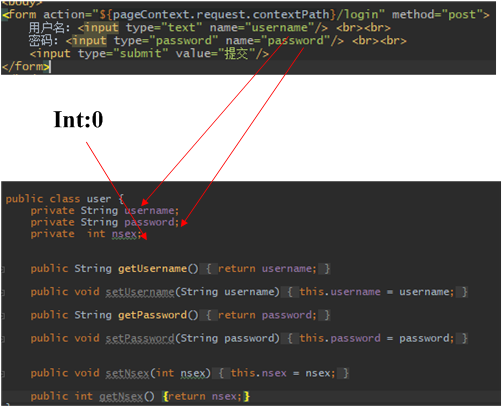1、通过注解ModelAttribute直接映射表单中的参数到POJO。在from中的action写提交的路径,在input的name写参数的名称。

package com.demo.model; public class user { private String username; private String password; private int nsex; public String getUsername() { return username; } public void setUsername(String username) { this.username = username; } public String getPassword() { return password; } public void setPassword(String password) { this.password = password; } public void setNsex(int nsex) { this.nsex = nsex; } public int getNsex() {return nsex;} }

<%-- Created by IntelliJ IDEA. User: wym Date: 2019/10/8 Time: 23:17 To change this template use File | Settings | File Templates. --%> <%@ page language="java" contentType="text/html; charset=UTF-8" pageEncoding="UTF-8"%> <!DOCTYPE html PUBLIC "-//W3C//DTD HTML 4.01 Transitional//EN" "http://www.w3.org/TR/html4/loose.dtd"> <html> <head> <meta http-equiv="Content-Type" content="text/html; charset=UTF-8"> <title>Login</title> </head> <body> <form action="${pageContext.request.contextPath}/login" method="post"> 用户名:<input type="text" name="username"/> <br><br> 密码:<input type="password" name="password"/> <br><br> <input type="submit" value="提交"/> </form> </body> </html>

package com.demo.controller; import com.demo.model.user; import com.demo.service.Userservice; import org.springframework.beans.factory.annotation.Autowired; import org.springframework.stereotype.Controller; import org.springframework.web.bind.annotation.ModelAttribute; import org.springframework.web.bind.annotation.RequestMapping; import org.springframework.web.bind.annotation.RequestMethod; import javax.servlet.http.HttpSession; @Controller public class LoginController { @Autowired private Userservice userService; @RequestMapping(value="/login", method= RequestMethod.POST) public String hello(@ModelAttribute user u, HttpSession session){ session.setAttribute("user", u); user user = userService.findbyname(u.getUsername()); if(user == null) return "loginfail"; else if(!user.getPassword().equals(u.getPassword())) return "falsepaswd"; else return "helloworld"; } }
注意!!这里只有input的参数name名称和pojo中的成员域名称完全相同才可以通过@ModelAttribute进行直接映射,否则无法被赋值的参数将会以默认值的方式呈现。

2.显然不可能form获取的内容总是某个pojo的属性,完全有可能是单独出现的。这时可以使用@RequestParam获取参数。
1 public String hello(@RequestParam(value="username") String A, @RequestParam(value="password") String B, HttpSession session){ 2 session.setAttribute("a", A); 3 session.setAttribute("b", B); 4 user user = userService.findbyname(A); 5 if(user == null) 6 return "loginfail"; 7 else if(!user.getPassword().equals(B)) 8 return "falsepaswd"; 9 else 10 return "helloworld"; 11 12 }
这时候只需跟在@RequestParam后的参数和form的name一致即可,String的名称可以随便取。
3.可以直接啥注解都不加,只需保证参数名称和form的name即可
public String hello( String username, String password, HttpSession session){ session.setAttribute("a", username); session.setAttribute("b", password); user user = userService.findbyname(username); if(user == null) return "loginfail"; else if(!user.getPassword().equals(password)) return "falsepaswd"; else return "helloworld"; }
4.通过HttpServletRequest接收
public String hello( HttpServletRequest req, HttpSession session){ username=req.getParameter("username"); password=req.getParameter("password"); session.setAttribute("a", username); session.setAttribute("b", password); user user = userService.findbyname(username); if(user == null) return "loginfail"; else if(!user.getPassword().equals(password)) return "falsepaswd"; else return "helloworld"; }
此外,还有一些其他的方式接受数据,例如通过@RequestBody等方式传递json数据。
